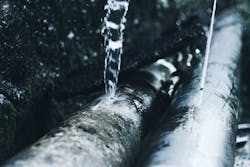Looking to space to tackle urban water crises
When you wake up, you pour yourself some water, brush your teeth, shower, and get ready for the day. Throughout the day, you cook some meals, wash some dishes, wash your hands, and water your plants.
Notice a theme? All of these things - and many other mundane moments in our days - require the most important resource of all: water. We take water for granted. Water seems infinite. But it’s far from that.
The world’s cities face a global water crisis as clean water becomes ever scarcer thanks to an imbalance between supply and demand. As urbanization progresses and climate change worsens, the outlook for future water availability is harrowing.
Despite this uncertainty, cities can help solve the global water crisis. We must look to scientists, engineers, planners, and designers for answers to the challenge of making our cities future proof. But beyond looking around us, we ought to look up to the skies, far above our skyscrapers.
It’s easy to take water for granted at home. When you’re flying through space in a tiny capsule, it’s not as easy.
The International Space Station (ISS) is Ground Zero for managing water like the valuable resource it is. Astronauts orbiting the Earth on board the ISS know firsthand the scarcity and value of clean water.
We can look to the ISS as a model for a way to treat water like the precious asset that it is.
Why We Must Think Differently About Water
A half century ago, when humans first ventured into space, people began to appreciate Earth’s uniqueness. The image of a tiny blue planet surrounded by darkness imbued our collective consciousness with a spirit of gratitude for the gift of living on this planet.
When those ISS astronauts look down at Earth, they see a planet whose surface is almost three-quarters covered by water. From that vantage point, water seems plentiful. But appearances can be deceiving.
Global water use has risen six-fold over the past century. In two decades, global water demand will exceed supply.
Nowhere will this stress be felt more acutely than in large cities, which both consume lots of water and acutely strain water systems and infrastructure. But cities treat water recklessly. It’s habitual to see 50% water loss through leaks in outdated water distribution systems in urban areas. That lost water alone could provide up to 20 million urbanites with clean water.
These daunting statistics underlie the need for a radically different mindset in regards to successfully coping with the water stress that will hit cities over the next few decades. For this mindset, we can crane our necks up and take some cues from our friends in the ISS.
How the ISS Can Teach Cities to Deal with Water Leaks
In space, leaks would cause catastrophes. Spacecraft engineers ensure structures like the ISS are 100% airtight. Ground control constantly monitors possible air leaks, finding and fixing any leaks as soon as possible.
Back on terra firma, 13% of household water in the U.S. is lost (on average) through leaky toilets, faucets, and appliances. That’s a lot of water - 25,000 liters annually per household and perhaps trillions of liters lost every year across the country.
If we considered those leak-driven losses as urgent as leaks in the ISS, we’d go a long way toward addressing the global water crisis. Fixing leaks is good both for the planet and for our wallets.
Zooming out from inside our houses to looking at our cities, the story is similar. A swelling urban population spurs more water demand but existing water infrastructure is mal-equipped to safely and efficiently allocate these amounts of water. Outdated supply and plumbing systems are in disrepair, and much of the water circulating through these outdated systems is either polluted or lost.
Cape Town paid a deep price for this kind of neglect a few years ago, when a severe drought strained an urban water system full of antiquated leaky pipes. The city nearly reached Day Zero, the point at which the municipal water supply would shut off. Cape Town banded together to win the battle against Day Zero, but residents endured crippling water shortages and other disruptions that cannot and should not become commonplace in urban life.
Potential crises like the Cape Town water shortage could be averted with smart technology. Pressure pipe renovation technology enables a complete renewal of underground water networks without digging a single hole. Like a heart surgeon placing a stent to clear an artery without having to perform open heart surgery, we can place these innovative pipes inside existing water pipes and then blow hot steam in the system, enabling the plastic piping to mold into shape. This leaves a new watertight pipe inside the existing pipe, allowing cities to fix leaks efficiently and effectively without having to perform open heart surgery on busy (and often clogged) city streets.
How Water Can be Used for Temperature Regulation
Water can be used for much more than just drinking and cleaning. The ISS experiences large temperature fluctuations as it orbits the Earth. Like the Moon, the ISS has two sides: one facing the Sun and the other facing away from it. The Sun-facing side can boil up to 250℉ (ca. 120℃), while on the ‘dark side’ it can drop below -250℉ (ca. -160℃).
As such, physics dictates a better approach to heat regulation. To keep the ISS and its equipment cool, engineers developed a special heat rejection system. Waste heat is transported through a closed network of water-filled pipes. Heat exchangers lose their heat by warming up the water, which in turn transports the heat to another set of ammonia-filled pipes. The ammonia pushes the heat outside of the ISS to radiators which finally transfer the excess heat into space. Thanks to this smart water use, the internal ISS temperature hovers at a constant and comfortable 75℉ (ca. 24℃).
Likewise, heating buildings by recirculating water through pipes is a common feature of underfloor heating systems. But staying warm isn’t the biggest problem for buildings; it’s staying cool. Building occupants around the world are increasingly turning to cooling via similar networks of pipes that run through both the floors and the ceiling. Compared to typical air conditioning, underfloor cooling is far more energy-efficient and creates a more comfortable thermal environment for humans.
In sum, when we look at water differently, we find it has a lot more to offer than we think.
Conclusion
It’s natural to think of water problems at a global (or intergalactic) level. But like many environmental challenges, this one must eventually be solved at the local level. Collaboration between different parties - concerned citizens, companies, researchers, governments, and the like - is a key factor here. These parties must work together to solve the water-related challenges that will strike urban areas.
Ingenuity can address different sources of water shortages. Water from both waste and the atmosphere can be captured and filtered to reduce water use. Water can be used for heat regulation, leading to less resources being used for heating and cooling. Implementing these concepts in one way or another into city systems will make a big difference, moving cities closer to a sustainable, future-proof vision.
Fortunately, awareness is growing for the upcoming water scarcity and the underlying problems. But knowledge, experience and legislation are moving too slow to get ahead of the imminent dangers we face. Ironically, water availability plays a big part here. As previously mentioned, water is readily available from the tap in urban areas, creating the illusion that clean water and drinking water are infinite. There is a clear need for a paradigm shift in the way we think about and handle clean water. Cities must treat water as an asset rather than a commodity.
We would like to invite the great thinkers on the ISS, at NASA, as well as the other space organizations to sit down with us and to share some more of their experiences on smart water use. We believe we can solve the world’s water challenges by learning from each other and working together.
To solve some of the most urgent challenges we face here on Earth, we can look to the heavens for inspiration, innovation, and ingenuity.






